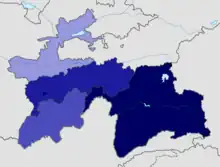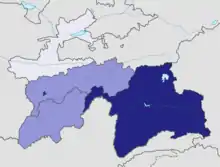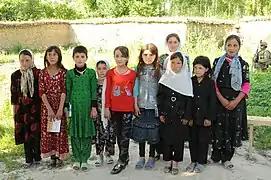Pamiris
The Pamiris[lower-alpha 1] are an Eastern Iranian ethnic group, native to the Badakhshan region of Central Asia, which includes the Gorno-Badakhshan Autonomous Region of Tajikistan; the Badakhshan Province of Afghanistan; Taxkorgan Tajik Autonomous County in Xinjiang, China; and the Upper Hunza Valley in Pakistan.
 Pamiri boy in Tajikistan | |
| Regions with significant populations | |
|---|---|
| Tajikistan (Gorno-Badakhshan) | 199,500[1] (2013) |
| China (Xinjiang) | 50,265[2] (2015) |
| Russia | 363[3] (2010) |
| Afghanistan (Badakhshan) | Unknown |
| Pakistan (Upper Hunza) | Unknown[4] |
| Languages | |
| Pamir languages, Tajik language, Russian language, Mandarin Chinese | |
| Religion | |
| Nizari Isma'ili Shia Islam as well as a minority of Sunnism adherents[5] | |
| Related ethnic groups | |
| Other Iranian peoples | |
Ethnic identity
The Pamiris are composed of people who speak the Pamiri languages, the indigenous language in the Gorno-Badakhshan autonomous province.[6] The Pamiris share close linguistic, cultural and religious ties with the people in Badakhshan Province in Afghanistan, the Sarikoli speakers in the Pamir region of Taxkorgan Tajik Autonomous County in Xinjiang Province in China and the Wakhi speakers in Afghanistan and Pakistan.[7] In the Pamiri languages, the Pamiris refer to themselves as Pamiri, a reference to the historic Badakhshan region where they live.
In China, Pamiris are referred to as ethnic Tajiks.[8] In Afghanistan, they are recognized as ethnic Pamiris[9] and the Afghan National Anthem mentions Pamiris (پاميريان, Pāmiryān) in the list of ethnic groups of Afghanistan.[10]

In Pakistan, Wakhi Pamiri people live in the Gojal Sub-Division of Hunza District, Broghil Valley of Upper Chitral & Karambar.

The Pamiri people have their own distinctive styles of dress, which can differentiate one community from the next. The styles of hats are especially varied: one can spot someone from the Wakhan, as opposed to from Ruhshon or Shugnon valleys, based solely on headwear.[11]
The Shughni and Wakhi tribes in Tajikistan call themselves "Tajik" unlike other Pamiri tribes in the area like the Rushan.[12]
History

Ancient History
The Pamiris are known to be the descendants of the Scythians who lived in Xinjiang.[13][14][15] The Wakhi group of the Pamiris linguistically seem to be related to the Khotanese group of Sakas.[16][17][18] The Wakhis had some point in the 6th century AD established a kingdom in Wakhan known as the Mirdom of Wakhan ruled by a mir.
Modern History
In 1929 Gorno-Badakhshan was attached to the newly formed republic of Tajikistan, and since that point, there has been a great deal of controversy surrounding the ethnic identity of the Pamiris. Some Tajik scholars claim Pamiri languages to be a dialects of Tajik language and there has been a long-running debate as to whether the Pamiris constituted a nationality separate from Tajiks.[19] But there is a consensus amongst linguists that the Pamiri languages are East Iranian, a sub-group of Iranian languages while Tajik language which like Persian is included in Southwestern Iranian, another sub-group of Iranian languages. In the 1926 and 1937 Soviet censuses Rushani, Shugni and Wakhis were counted as separate nationalities. After 1937 these groups were required to register as Tajiks.[20]
During the Soviet period many Pamiris migrated to the Vakhsh River Valley and settled in Qurghonteppa Oblast, in what is today Khatlon Province. In the 1980s debate raged in Tajikistan about the official status of the Pamiri languages in the republic. After the independence of Tajikistan in 1991 Pamiri nationalism stirred and the Pamiri nationalist political party Lali Badakhshan took power in Gorno-Badakhshan. Anti-government protests took place in the province's capital, Khorog, and in 1992 the republic declared itself an independent country. This declaration was later repealed. During the Tajikistan Civil War from 1992 to 1997 Pamiris in large part backed the United Tajik Opposition, the Pamiris were targeted for massacres, especially those living in the capital Dushanbe and Qurghonteppa Oblast. In the early 1990s there was a movement amongst Pamiris to separate Gorno-Badakhshan from Tajikistan.[21]
Religion
Fatimid-Ismāʿīlī Islam had been introduced to the Badakhshan and Pamir (valley) by Nasir Khusraw al-Qubadiani, who was appointed as the Dā'ī al-Mutlaq and Hujjat al-Islam by Fatimid Caliph Abū Tamīm Ma'add al-Mustanṣir bi-llāh for Pamiris in Xinjiang and Badakhshan in Afghanistan.[22] Today's Pamiris are predominantly Nizārī Ismā'īlī Shia and follow the Aga Khan.[23]
The Aga Khan Foundation became the primary non-governmental organization in Gorno-Badakhshan. There are also Sunni Pamiris currently numbering at approximately a few thousand.[6] These Pamiris' ancestors converted to Sunni Islam around the 19th century.[24]
Culture
The Pamiris mainly engage in agriculture and animal herding. They commonly cultivated crops include wheat, barley, peas, and vegetables. The Pamiris raise sheep, yaks, and goats.[25]
Pamiri music has been popularised by folk singer Oleg Fesov.[26]
Notable individuals

- Shirinsho Shotemur, politician, one of the founders of the Tajik Soviet Socialist Republic
- Davlat Khudonazarov, filmmaker and presidential candidate in 1991 presidential elections in Tajikistan
- Muboraksho Mirzoshoyev, musician
- Daler Nazarov, musician and actor
- Abusaid Shokhumorov, historian and philosopher
- Qozidavlat Qoimdodov Tajikistani politician who served as an ambassador and deputy prime minister
- Oleg Fesov, musician and composer
- Manuchehr Kholiqnazarov, human rights activist
Gallery
 Pamiri children in Afghanistan
Pamiri children in Afghanistan Pamiri woman and boy in Tajikistan
Pamiri woman and boy in Tajikistan Pamiri children in Afghanistan
Pamiri children in Afghanistan Wakhi Pamiri artists in Gojal Valley, Pakistan.
Wakhi Pamiri artists in Gojal Valley, Pakistan.
Notes
References
- "PAMIRI TAJIKS AND YAGHNOBIS | Facts and Details".
- 泽普概况. 泽普政府网 (in Simplified Chinese). 17 July 2017. Archived from the original on 26 January 2020. Retrieved 10 April 2020 – via Internet Archive.
2016年末,全县总户数(含塔西南勘探开发公司)65684户,其中县属户数59804户;总人口208950人(含塔西南勘探开发公司),其中,维吾尔族175686人,占84.1%,汉族27131人,占13%,塔吉克族4463人,占2.1%,其他民族1670人,占0.8%。
- Russian Census 2010: Population by ethnicity (in Russian)
- "Here is why Pakistan is more diverse than you thought". 22 December 2016.
- Islamic peoples of the Soviet Union, pg. 33 By Shirin Akiner
- Akiner, Shirin (1986). Islamic Peoples of the Soviet Union. London: Kegan Paul International. pp. 33, 374–375. ISBN 0-7103-0188-X.
- "Where music meets mountains: A school to preserve Pamiri music". The Express Tribune. 18 February 2017. Retrieved 14 July 2023.
- Foltz, Richard (2019). A History of the Tajiks: Iranians of the East. New York: I.B. Tauris. p. 183. ISBN 978-1-83860-446-2.
- Minahan, James B. (10 February 2014). Ethnic Groups of North, East, and Central Asia: An Encyclopedia. ABC-CLIO.
- "Afghan National Anthem". Nationalanthems.info. Retrieved 21 June 2012.
- "The Pamiris: People on the Roof of the World". Paramount Journey. 7 September 2016. Retrieved 7 September 2016.
- Schoeberlein-Engel, John Samuel (1994). Identity in Central Asia: Construction and Contention in the Conceptions of "Özbek," "Tâjik, " "Muslim, " "Samarqandi" and Other Groups. Central Asia: Harvard University. p. 113.
- Kuzʹmina, Elena Efimovna (2007). The Origin of the Indo-Iranians. BRILL. ISBN 978-90-04-16054-5.
- Foltz, Richard (30 December 2021). The Ossetes: Modern-Day Scythians of the Caucasus. Bloomsbury Publishing. ISBN 978-0-7556-1847-7.
- Kreutzmann, Hermann; Watanabe, Teiji (25 January 2016). Mapping Transition in the Pamirs: Changing Human-Environmental Landscapes. Springer. ISBN 978-3-319-23198-3.
- Comrie, Bernard (17 April 2018). The World's Major Languages. Routledge. ISBN 978-1-317-29049-0.
- Concise Encyclopedia of Languages of the World. Elsevier. 6 April 2010. p. 603. ISBN 978-0-08-087775-4.
- Erdosy, George (25 October 2012). The Indo-Aryans of Ancient South Asia: Language, Material Culture and Ethnicity. Walter de Gruyter. p. 159. ISBN 978-3-11-081643-3.
- Cheshko, S. V. (1989). "Не Публицистично, Но И Не Научно". Sovetskaya Etnografiya Akademiya Nauk SSR I Narodnyi Komisseriat Prosveshcheniya RSFSR (5): 23–38.
- Suny, Ronald Grigor (2006). "History and Foreign Policy: From Constructed Identities to "Ancient Hatreds" East of the Caspian". In Shaffer, Brenda (ed.). The Limits of Culture: Islam and Foreign Policy. MIT Press. pp. 100–110. ISBN 0-262-69321-6.
- Suhrobsho Davlatshoev (2006). "The Formation and Consolidation of Pamiri Ethnic Identity in Tajikistan. Dissertation" (PDF). School of Social Sciences of Middle East Technical University, Turkey (M.S. thesis). Retrieved 25 August 2006.
- Balcıoğlu, Tahir Harimî [in Turkish] (1940). Hilmi Ziya Ülken (ed.). Türk tarihinde mezhep cereyanları (in Turkish). İstanbul: Kanaat Yayınları, Ahmed Sait tab'ı. p. 136. Chapter on Mısır Fâtımîleri ve Aleviler'in Pamir Teşkilâtı.
- Salopek, Paul (9 October 2017). "Islam in Hiking Sandals—and Red Spike Heels". National Geographic. Retrieved 14 October 2017.
If these women are extraordinary, it's partly because Pamiri culture is special. They are followers of Ismailism, a tolerant branch of Islam led by the 49th Agha Khan, a spiritual and temporal leader descended from the Prophet Mohammed.
- Bennigsen, Alexandre; Wimbush, S. Enders (1986). Muslims of the Soviet Empire: A Guide. Indiana University Press. p. 122. ISBN 978-0-253-33958-4.
- West, Barbara A. (2010). Encyclopedia of the Peoples of Asia and Oceania. Infobase Publishing. p. 634. ISBN 978-1-4381-1913-7.
- Dwek, Joel (30 March 2021). "TAJIKISTAN: Lalaiki Pamir - Oleg Fesov". 200worldalbums.com. Retrieved 12 September 2023.
External links
- United Nations University (2009) Digital Video "Pamiri women and the melting glaciers of Tajikistan": three generations of Pamiri women share the impacts of Pamir Mountain glacier melt and decreasing water levels on YouTube 1 December 2009